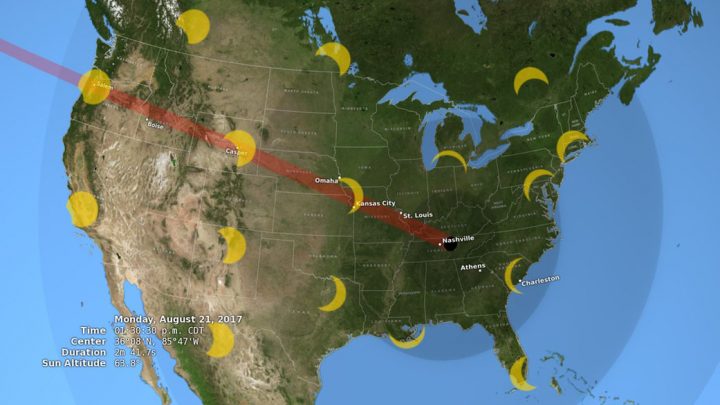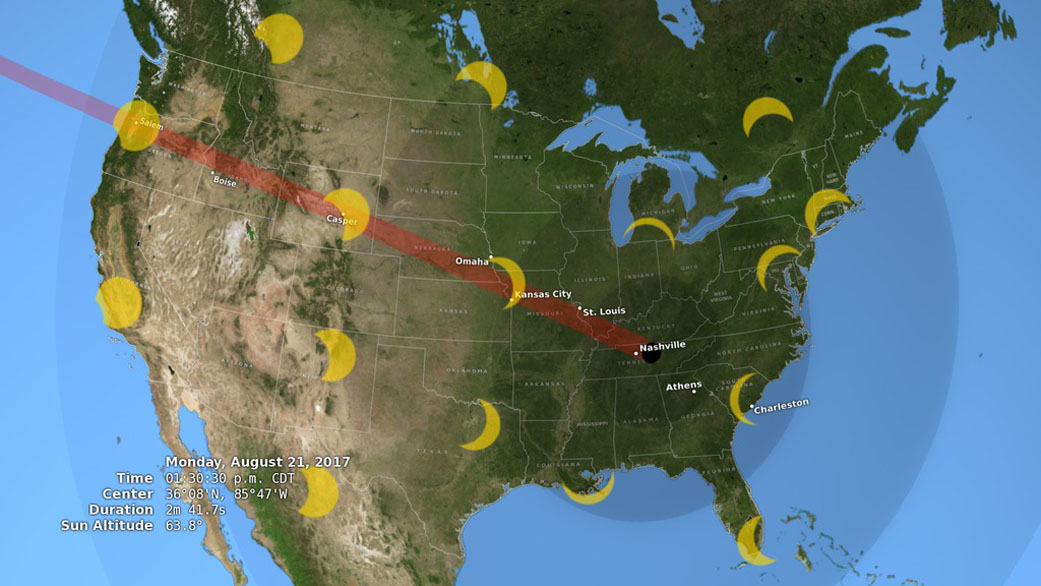
On Aug. 21, all of North America – as well as parts of South America, Europe and Africa – will, weather permitting, be able to view a partial eclipse of the sun. In Indiana, there will be a partial eclipse with 91 percent totality, beginning at approximately 2:25 p.m. and lasting approximately 2 hours and 50 minutes.
A total eclipse will be viewable to the select 12.2 million Americans living within the path of totality, a 70-mile band stretching across 14 states from Oregon to South Carolina.
The moon will pass between the earth and the sun on a west-to-east trajectory and completely eclipse the sun first in Lincoln Beach, Ore. at 10:16 a.m. (Pacific time) and last in Charleston, S.C. at 2:48 p.m. (Eastern time). The longest period of totality will occur in Carbondale, Ill., for a full two minutes and 40 seconds, with this interval being shorter in other places. This is the first time in 100 years that a total eclipse has crossed the span of the continent.
Why solar eclipses occur
The moon moves in an orbit around the Earth, which in itself orbits the sun. Even though the sun is in fact many times bigger than the moon, due to the vast difference between where these two celestial bodies are located, they appear to be the approximately the same size when viewed from Earth. When the moon’s trajectory overlaps, the sun’s position in relation to a given point on Earth, we experience either a partial or total eclipse, a phenomenon that generally takes place over a three-hour period.
Viewing the eclipse safely
Eclipses are inspiring natural occurrences that can and should be admired. However, certain precautions need to be taken when viewing them. In general, staring at the sun’s surface for too long can cause damage to the eye, but during an eclipse, the surrounding darkness sways the natural tendency to divert one’s gaze, thereby allowing even more of the sun’s ultraviolet radiation to impact the retina. Even when 99 percent of the sun’s surface is obscured during the partial phases of an eclipse, the remaining crescent of sun is still intense enough to cause retinal burn. However, a total solar eclipse can safely be viewed with the naked eye, but only for the brief minute or two in which the sun is completely obscured by the moon.
To view the eclipse safely, people need to acquire a pair of special eclipse glasses. Some libraries, science and astronomy clubs and historical societies are offering the glasses for free. Alternatively, you can purchase them online, but be careful to only get products that comply with the ISO 12312-2 international safety standard for filters for direct viewing of the sun. It is notsafe to view the eclipse with regular sunglasses.
If using a telescope, make certain the appropriate filter is in place before pointing it at the sun.
NASA live streaming
NASA will host an Eclipse Megacast, providing unique coverage of the astronomical event that will include commentary from scientists and the public, as well as live footage of the phenomenon. The Megacast will be broadcast on NASA TV, as well as a number of other TV stations, and can also be accessed online at nasa.gov/eclipselive.
The next total solar eclipse viewable in North America won’t occur till 2024.



